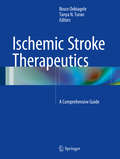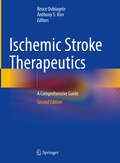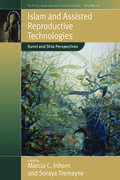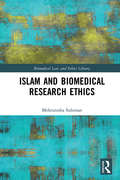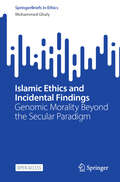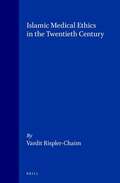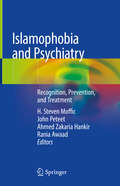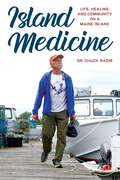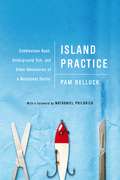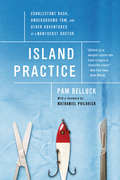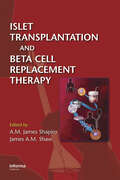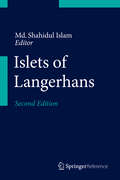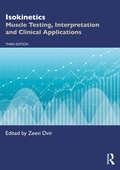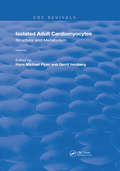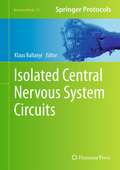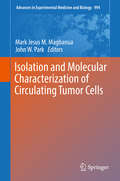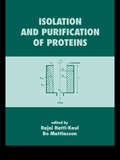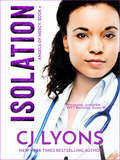- Table View
- List View
Ischemic Stroke Therapeutics
by Bruce OvbiageleThis complete resource captures state-of-the-art strategies and the accelerated pace of discovery that is revolutionizing what is known about ischemic stroke and its treatment. Therapeutics for acute management, secondary prevention, recovery, rehabilitation, asymptomatic cerebral ischemia, and implementation of stroke systems of care are all discussed in this comprehensive yet practical guide. Chapters are authored by leading academicians with extensive clinical practice experience from all over the world and feature the scientific evidence behind prevailing therapeutic strategies for managing ischemic cerebrovascular disease. The specialist or general practitioner will gain critical knowledge in stroke management, current clinical challenges and promising new therapies under investigation.
Ischemic Stroke Therapeutics: A Comprehensive Guide
by Bruce Ovbiagele Anthony S. KimThis second edition updates established evidence for contemporary management of ischemic stroke. Therapeutics for acute management, secondary prevention, recovery, rehabilitation, asymptomatic cerebral ischemia, special populations, and implementation of stroke systems of care are all discussed. Chapters are authored by leading academicians from around the world with real-world clinical practice experience, and comprise the scientific rationale and expert consensus recommendations, which underlie prevailing (and possibly future) therapeutic strategies for managing ischemic cerebrovascular disease. New chapter topics include neuroprotectants, treatment of the oldest old, brain-computer interfaces, disparities, and the global burden. The specialist or general practitioner will gain critical knowledge in stroke management, current clinical challenges and promising new therapies under investigation.
Ischemic Stroke: Diagnosis and Treatment (Current Clinical Cardiology)
by Liliana Cohen Michael G Fara Christopher Favilla Rahul Garg Toby Ira Gropen Nneka Ifejika Koto Ishida Lester Y Leung Ava L Liberman Kira Long James S. McKinney Deviyani Mehta Steven R Messe Michael T Mullen Vikas G Patel Christopher J Renner Igor Rybinnik Amardeep Saluja Albert D Sam Rajbeer S Sangha Steven M Schonfeld Christina Mijalski Sells James E Siegler Magdy Selim Joseph Tarsia Monica Verduzco-Gutierrez Linda Wendell Ashlie White Frank WilklowStroke is the fifth leading cause of death in the United States and is a leading cause of adult disability and discharge from hospitals to chronic care facilities. Despite the frequency and morbidity of stroke, there is a relative paucity of “stroke experts,” such as vascular neurologists and neurocritical care physicians, to care for these patients. Clinical research in the diagnosis and treatment of stroke has grown exponentially over the past two decades resulting in a great deal of new clinical information for attending physicians to absorb. Grounded in cutting-edge and evidence-based strategies, Ischemic Stroke closes the gap in stroke care by providing a cogent and intuitive guide for all physicians caring for stroke patients. Key topics explored cover all elements of stroke care, including examinations of: emergent evaluation of the suspected stroke patient, clinical signs and symptoms of stroke, mechanisms of ischemic stroke, neuroimaging, cardiac-based evaluation, thrombolytic therapy, endovascular therapy, critical care management, rehabilitation, cardiac arrhythmias, and structural heart disease.
Islam and Assisted Reproductive Technologies
by Marcia C. Inhorn Soraya TremayneHow and to what extent have Islamic legal scholars and Middle Eastern lawmakers, as well as Middle Eastern Muslim physicians and patients, grappled with the complex bioethical, legal, and social issues that are raised in the process of attempting to conceive life in the face of infertility? This path-breaking volume explores the influence of Islamic attitudes on Assisted Reproductive Technologies (ARTs) and reveals the variations in both the Islamic jurisprudence and the cultural responses to ARTs.
Islam and Biomedical Research Ethics (Biomedical Law and Ethics Library)
by Mehrunisha SulemanThis book is a contribution to the nascent discourse on global health and biomedical research ethics involving Muslim populations and Islamic contexts. It presents a rich sociological account about the ways in which debates and questions involving Islam within the biomedical research context are negotiated - a perspective which is currently lacking within the broader bioethics literature. The book tackles some key understudied areas including: role of faith in moral deliberations within biomedical research ethics, the moral anxiety and frustration experienced by researchers when having to negotiate multiple moral sources and how the marginalisation of women, the prejudice and abuse faced by groups such as sex workers and those from the LGBT community are encountered and negotiated in such contexts. The volume provides a valuable resource for researchers and scholars in this area by providing a systematic review of ethical guidelines and a rich case-based account of the ethical issues emerging in biomedical research in contexts where Islam and the religious moral commitments of Muslims are pertinent. The book will be essential for those conducting research in low and middle income countries that have significant Muslim populations and for those in Muslim-minority settings. It will also appeal to researchers and scholars in religious studies, social sciences, philosophy, anthropology and theology, as well as the fields of biomedical ethics, Islamic ethics and global health..
Islam and Biomedicine (Philosophy and Medicine #137)
by Afifi Al-Akiti Aasim I. PadelaThis book showcases multidisciplinary research at the intersection of the Islamic tradition and biomedicine. Within this broad area of scholarship, this book considers how Islamic theological constructs align with the science and practice of medicine, and in so doing offer resources for bridging the challenges of competing ontological visions, varied epistemic frameworks, and different theologies of life and living among the bodies of knowledge. By bringing together theologians, medical practitioners and intellectual historians, the book spurs deeper conversations at the intersection of these fields and provides fundamental resources for further dedicated research.
Islam and New Kinship: Reproductive Technology and the Shariah in Lebanon (Fertility, Reproduction and Sexuality: Social and Cultural Perspectives #16)
by Morgan ClarkeAssisted reproductive technologies such as in vitro fertilization have provoked global controversy and ethical debate. This book provides a groundbreaking investigation into those debates in the Islamic Middle East, simultaneously documenting changing ideas of kinship and the evolving role of religious authority in the region through a combination of in-depth field research in Lebanon and an exhaustive survey of the Islamic legal literature. Lebanon, home to both Sunni and Shiite Muslim communities, provides a valuable site through which to explore the overall dynamism and diversity of global Islamic debate. As this book shows, Muslim perspectives focus on the moral propriety of such controversial procedures as the use of donor sperm and eggs as well as surrogacy arrangements, which are allowed by some authorities using surprising and innovative legal arguments. These arguments challenge common stereotypes of the rigidity and conservatism of Islamic law and compel us to question conventional contrasts between ‘liberal’ and Islamic notions of moral freedom, as well as the epistemological assumptions of anthropology’s own ‘new kinship studies’. This book will be essential reading for anyone interested in contemporary Islam and the impact of reproductive technology on the global social imaginary.
Islamic Approaches to Patient Care: Muslim Beliefs and Healthcare Practices for Caregivers
by Ra'Ufa TuellWhy do Muslims bury their dead within 24 hours? Why do Muslim patients want same-gender care? Does Islam really sanction female circumcision? Does it permit contraception and abortion? If so, under what circumstances? Islamic Approaches to Patient Care Muslim Beliefs and Healthcare Practices for Caregivers answers these and many more questions from a Muslim perspective. It offers what s not been published before: a detailed and practical step-by-step guide to culturally sensitive care. For most Muslims, Islamic practices and beliefs permeate many aspects of day-to-day life and these become particularly evident in a healthcare setting. In this book, the author a Muslim hospital chaplain explains why. She interfaces Islamic law and medical ethics with such issues as abortion, autopsy, childbirth, female and male circumcision, death and dying, euthanasia, fertility regulation, infertility treatment, organ transplantation, stem cell research, suicide, and assisted suicide. She also explores dietary restrictions and haram (forbidden) foods, gender modesty and the veiling of women, piety and prayer, and many other relevant topics. In addition, the book includes an extensive section on commonly used phrases and prayers in transliterated Arabic, as well as applicable passages from the Qur'an. As the world s Muslim population continues to surge, particularly in non-Muslim countries, Islamic Approaches to Patient Care can serve as a much-needed resource: a timely, informative, and clearly articulated guide.
Islamic Ethics and Incidental Findings: Genomic Morality Beyond the Secular Paradigm (SpringerBriefs in Ethics)
by Mohammed GhalyThis open access book offers unique insights into the key ethical issues faced by practitioners and discussed by ethicists in the field of genomics and incidental findings, with a focus on the Islamic moral tradition. Embark on an enlightening exploration of key ethical challenges in genomics and incidental findings, uniquely tailored to the context of the Muslim Arab world. Following the regional scientific leap in genomic infrastructure, this study provides a timely response to the need for a solid evidence base that pairs scientific research with cutting-edge research in Islamic ethics. A variety of expert perspectives have been incorporated, which produce a holistic overview of the intricate, interwoven systems, including the status quo of genomic research in the Gulf region, related Islamic ethical deliberations, and, finally, the governing jurisdictions and regulations on the ground. This publication stands as a pioneer work for academics interested in various fields, including genomics, bioethics, and Islamic studies. It equally serves as an invaluable guide for practitioners and policy-makers, equipping them to make informed decisions that resonate with the socio-cultural and religio-ethical nuances of the Islamic tradition. Being multidisciplinary in nature, the study is written in such a way that makes it accessible for those without a specialized background in Islamic studies or genomics.
Islamic Medical Ethics In The Twentieth Century
by C. A. O. van NieuwenhuijzeConsiders prominent issues in medical ethics in the 20th century, such as abortion, artificial insemination, organ transplantation, euthanasia as discussed by Muslim religious scholars, physicians and jurists. Despite the semi-equal spread of medical knowledge among the peoples of the world and the shared dilemmas brought about by modern medicine, Muslims tend to follow their own medical ethics, which agree ultimately with the basic requirements of Islamic religion and law.
Islamophobia and Psychiatry: Recognition, Prevention, And Treatment
by H. Steven Moffic John Peteet Ahmed Zakaria Hankir Rania AwaadThe book begins by covering the general and clinical challenges that are unique to Muslims, drawing from an internationally, ethnically, and intergenerationally diverse pool of experts. The text covers not only how psychiatrists and other clinicians can intervene successfully with patients, but how we as clinicians can have a role in addressing other societally connected mental health challenges arising from Islamophobia. The text addresses three related but distinct areas of interest: Islamophobia as a destructive force, Islam as a religion that is threatened by stigma and misinformation, and the novel intersection of these forces with the field of psychiatry. Islamophobia and Psychiatry is a vital resource for all clinicians and clinicians in training who may encounter patients struggling with these issues, including adult and child psychiatrists, psychologists, primary care physicians, counselors, social workers, and others.
Island Fling with the Surgeon
by Ann McIntoshMake-believe?Or more than she bargained for?When Dr. Genevieve Broussard convinces nurse Zach Lewin to enter a fake relationship to help keep her meddling mom off her back, she&’s confident there&’s no danger of it turning into anything more. Her first priority has to be her surgical career, and both Gen and Zach are still reeling from recent betrayals. But as the summer heat in the Caribbean loosens inhibitions, their fake &“affair&” is at risk of becoming all too real… &“I really enjoyed this story! I thought that it was a good storyline that was well developed and I found it to be an additive read. There was great detail to make the story flow really well without it getting bogged down. It was a romance that had me turning pages to find out what would happen and I really enjoyed that…highly recommended!&”-Goodreads on Night Shifts with the Miami Doc &“I found Ann McIntosh&’s Christmas with Her Lost-and-Found Lover to be an exciting, entertaining and adorable read. I really, really enjoyed it and would recommend it to anyone who loves their heroines motivated and smart and their heroes loving and genuine. Wonderful read!&”-Harlequin Junkie
Island Medicine: Life, Healing, and Community on a Maine Island
by Dr. Chuck RadisDr. Chuck Radis was drawn to a career in medicine after meeting an osteopathic family practice bush pilot in Baja, Mexico. Following an internal medicine residency, the young doctor moved his family to Peaks Island off the coast of Maine and traveled by boat to the four year-round islands in Casco Bay, logging more than 100 house calls each year. Come along with Dr. Radis as he makes his rounds with a new batch of stories filled with equal parts hilarity, heartache, and wisdom.
Island Practice
by Pam BelluckWith a Foreword by Nathaniel Philbrick, author of the bestseller In the Heart of the Sea If you need an appendectomy, he can do it with a stone scalpel he carved himself. If you have a condition nobody can diagnose--"creeping eruption" perhaps--he can identify what it is, and treat it. A baby with toe-tourniquet syndrome, a human leg that's washed ashore, a horse with Lyme disease, a narcoleptic falling face-first in the street, a hermit living underground--hardly anything is off-limits for Dr. Timothy J. Lepore. This is the spirited, true story of a colorful, contrarian doctor on the world-famous island of Nantucket. Thirty miles out to sea, in a strikingly offbeat place known for wealthy summer people but also home to independent-minded, idiosyncratic year-rounders, Lepore holds the life of the island, often quite literally, in his hands. He's surgeon, medical examiner, football team doctor, tick expert, unofficial psychologist, accidental homicide detective, occasional veterinarian. When crisis strikes, he's deeply involved. He's treated Jimmy Buffett, Chris Matthews, and various Kennedy relatives, but he makes house calls for anyone and lets people pay him nothing--or anything: oatmeal raisin cookies, a weather-beaten . 44 Magnum, a picture of a Nepalese shaman. Lepore can be controversial and contradictory, espousing conservative views while performing abortions and giving patients marijuana cookies. He has unusual hobbies: he's a gun fanatic, roadkill collector, and concocter of pastimes like knitting dog-hair sweaters. Ultimately, Island Practice is about a doctor utterly essential to a community at a time when medicine is increasingly money-driven and impersonal. Can he remain a maverick even as a healthcare chain subsumes his hospital? Every community has--or, some would say, needs--a Doctor Lepore, and his island's drive to retain individuality in a cookie-cutter world is echoed across the country.
Island Practice: Cobblestone Rash, Underground Tom, and Other Adventures of a Nantucket Doctor
by Pam BelluckIf you need an appendectomy, he can do it with a stone scalpel he carved himself. If you have a condition nobody can diagnose--"creeping eruption" perhaps--he can identify what it is, and treat it. A baby with toe-tourniquet syndrome, a human leg that's washed ashore, a horse with Lyme disease, a narcoleptic falling face-first in the street, a hermit living underground--hardly anything is off-limits for Dr. Timothy J. Lepore. This is the spirited, true story of a colorful, contrarian doctor on the world-famous island of Nantucket. Thirty miles out to sea, in a strikingly offbeat place known for wealthy summer people but also home to independent-minded, idiosyncratic year-rounders, Lepore holds the life of the island, often quite literally, in his hands. He's surgeon, medical examiner, football team doctor, tick expert, unofficial psychologist, accidental homicide detective, occasional veterinarian. When crisis strikes, he's deeply involved. He's treated Jimmy Buffett, Chris Matthews, and various Kennedy relatives, but he makes house calls for anyone and lets people pay him nothing--or anything: oatmeal raisin cookies, a weather-beaten .44 Magnum, a picture of a Nepalese shaman. Lepore can be controversial and contradictory, espousing conservative views while performing abortions and giving patients marijuana cookies. He has unusual hobbies: he's a gun fanatic, roadkill collector, and concocter of pastimes like knitting dog-hair sweaters. Ultimately, Island Practice is about a doctor utterly essential to a community at a time when medicine is increasingly money-driven and impersonal. Can he remain a maverick even as a healthcare chain subsumes his hospital? Every community has--or, some would say, needs--a Doctor Lepore, and his island's drive to retain individuality in a cookie-cutter world is echoed across the country.
Island of Reil (Insula) in the Human Brain: Anatomical, Functional, Clinical and Surgical Aspects
by R. Shane Tubbs Mehmet Turgut Canan YurttaşThis book provides an in-depth review of the insula, with emphasis on anatomical, diagnostics, clinical, and surgical features. The insular cortex is involved in a variety of functions, but a comprehensive resource cataloging these functions is not available in the current literature. This book gathers highly informative chapters written and edited by leading international authorities in the field and covers the full range of the insular cortex, approaching it in four main sections: firstly, the embryology and anatomy of the human insula; secondly, the functions of the human insula, including its role in nociception, language, decision making, cognition, emotional awareness etc.; thirdly, clinical disorders related to the insula such as epilepsy, schizophrenia, and Parkinson’s disease; and fourthly, surgical techniques for insular gliomas and temporal lobe epilepsy. This comprehensive reference book will be an ideal source for neurosurgeons, neurologists and neuroanatomists seeking both basic and more advanced information regarding this unique structure in the human brain.
Island of the Innocent (Cheney Duvall, M. D. Ser. #7)
by Lynn MorrisSHILOH IRONS HAS LEFT SAN FRANCISCO to investigate possible connections to his long-lost family heritage in Hawaii. Yet Cheney discovers disturbing facts about the family he is about to meet and determines she must follow Shiloh across the Pacific to warn him. Further, it seems the only tangible clues to his origins have been stolen... But fiery destruction spewing from the top of Mount Haleakala brings more immediate peril to the island, and Cheney's medical abilities are stretched to their limits. When she is caught between a river of lava creeping toward the beach and waters churning with frenzied sharks and poisonous Portuguese man-of-wars, she wonders if she will ever see Shiloh again. Will Cheney and Shiloh ever discover the truth about his heritage... and about each other?
Islet Transplantation and Beta Cell Replacement Therapy
by Ian MuehlenhausBeta cell replacement through transplantation remains the only treatment option for Type 1 diabetes enabling restoration of near-physiological glucose levels without significant hypoglycemia. Outlining the most recent advances and research breakthroughs, this practical guide and reference work explores the impact of islet cell transplantation and b
Islets of Langerhans
by Md. Shahidul IslamThis book contains critical background information, and recent advances made in essentially all areas of islet research. It is a major reference book, the first of its kind, for islet researchers, and diabetes researchers. Anybody, including the experts, and the beginners, interested in the study of islet physiology, and diabetes, will find this book extremely useful. The book is robust in its breadth: it deals with anatomy, histology, ultra-structure, evolution and comparative anatomy, imaging, developmental biology, programming, apoptosis, mitochondrial function, metabolism, cellular signaling, electrophysiology, oscillation of hormone secretion, islets of model animals, immunology, proteomics, regenerative medicine, clinical advances, and islet transplantation. Individual chapters contributed by a large number of experts and enthusiasts, not only provide a balanced view of the recent advances made in the respective fields, but also provide directions and thoughts for future research. Thanks to vivid and colorful illustrations, tables and sketches, the book as a whole, and the individual chapters make reading a pleasant experience. If you are interested in diabetes research, you will love to have a personal copy of this book.
Isokinetics: Muscle Testing, Interpretation and Clinical Applications
by Zeevi DvirIn this fully revised third edition of Isokinetics: Muscle Testing, Interpretation and Clinical Applications, a group of international experts cover the main developments that have taken place in the field of isokinetics in the last 20 years. Isokinetic dynamometry is well recognized as the standard in assessing muscular strength status and particularly its variation following intervention. Key features of this Third Edition; New chapter on multiple joint isokinetic testing New chapter on isokinetic reconditioning in the clinical setting New chapter on isokinetics in neurological disorders New chapter on isokinetics in neuromuscular diseases New chapter on isokinetic testing and training in the elderly New chapter on isokinetic testing in children Isokinetics Third Edition provides a wealth of essential information for those especially concerned with the assessment of muscle function due to disease or injury and its rehabilitation. This fully revised book is essential reading for orthopedic and sports physicians, neurologists, physical therapists, exercise physiologists and related professionals who will find the 3rd edition an important clinical reference for their effective practice.
Isolated Adult Cardiomyocytes: Structure and Metabolism (Routledge Revivals #1)
by Hans Michael Piper Gerrit IsenbergFirst published in 1989, written with contributions from experts who have critically evaluated the state of the art and the prospects of isolated adults cardiac myocytes in cardiological research, this two-volume publication summarizes the current knowledge of this technology. The methodology, structure, and metabolism of cardiomyocytes are presented, along with metabolism and cation homeostasis and energy metabolism and hypoxic injury. Additionally, cell isolation and culture and the structure and biochemistry of the sarcolemma is explained. Electrophysiology and contractile function with ionic currents and membrane channels is discussed. Also, the electro-physiological effects of transmitters and hormones are presented, with excitation-contraction coupling and the use of cardiomyocytes in drug design and research explained.
Isolated Central Nervous System Circuits
by Klaus BallanyiAdvances in methodologies and experimental models are pivotal to furthering our understanding of central nervous system (CNS) functions in mammals. Isolated Central Nervous System Circuits examines the application a variety of technologies to mostly active in vitro preparations from basically different CNS regions with a diversity of functions. From patch-clamp, multiphoton imaging, live fluorescent protein expression, or immunohistochemistry techniques to acute or 'organotypic' slices and en bloc preparations, this detailed volume features key protocols and examples for exciting results from the labs of renowned experts. Written for the popular Neuromethods series, chapters include the kind of thorough implementation advice that is vital for achieving successful results. Comprehensive and cutting-edge, Isolated Central Nervous System Circuits will greatly aid scientists to further improve models and to develop corresponding models of not yet intensively studied structures such as nucleus ruber, superior colliculus, or basal ganglia.
Isolation and Molecular Characterization of Circulating Tumor Cells
by John W. Park Mark Jesus MagbanuaNumerous studies have shown that elevated levels of circulating tumor cells (CTCs) in blood of cancer patients are associated with poor response to treatment and inferior survival probabilities. Despite this clinical significance, the molecular biology of CTCs remains poorly understood. The paucity in molecular information can be attributed to the tremendous technical challenges involved in isolating these extremely rare cells. Recent technological advancements in rare-cell technology, however, have allowed for the reliable enrichment and isolation of CTCs. Consequently, the use of recently developed molecular approaches —e.g., multiplexed QPCR, microarray, and next generation sequencing analyses— to profile CTCs have provided novel insights into the molecular makeup of these tumor cells. This book discusses approaches for enrichment and isolation of CTCs as well as recent advances in comprehensive molecular profiling of CTCs using cutting-edge omics technology.
Isolation and Purification of Proteins (Biotechnology And Bioprocessing Ser. #Vol. 27)
by Rajni Hatti-Kaul Bo MattiassonThis publication details the isolation of proteins from biological materials, techniques for solid-liquid separation, concentration, crystallization, chromatography, scale-up, process monitoring, product formulation, and regulatory and commercial considerations in protein production. The authors discuss the release of protein from a biological host, selectivity in affinity chromatography, precipitation of proteins (both non-specific and specific), extraction for rapid protein isolation, adsorption as an initial step for the capture of proteins, scale-up and commercial production of recombinant proteins, and process monitoring in downstream processing.
Isolation: Angels Of Mercy Book 4 (Angels of Mercy Medical Suspense #4)
by CJ LyonsNew York Times–Bestselling Author: Trapped in the ER during a blizzard on New Year’s Eve, their only resolution is to stay alive . . . “Harrowing . . . irresistible.” —Susan WiggsWith Pittsburgh snarled by a New Year’s Eve blizzard and Angels of Mercy Hospital cut off from the outside world, staff and patients are at the mercy of armed gunmen. Their target is Dr. Gina Freeman, who is holding vigil over her wounded fiancé, Detective Jerry Boyle.Trapped inside with her are ER charge nurse Nora Halloran and fourth-year medical student Amanda Mason, on the last night of her ICU rotation—and possibly her life. Stranded outside the hospital walls is ER physician Lydia Fiore, whose past holds the secret the hitmen are willing to kill for. With patients, staff, and loved ones held hostage, the power out, and cold-blooded killers in control, who will live to see the New Year?Previously published as Critical ConditionPraise for CJ Lyons’ Thrillers with Heart: “It’s easy to see why CJ Lyons is a perennial on the bestseller lists.” —Tess Gerritsen, New York Times–bestselling author of the Rizzoli & Isles novels“Gets the blood pumping . . . fans of Michael Palmer will enjoy this.” —The Mystery Gazette “A powerful and dramatic look into the frenzied world of emergency medicine.” —Suspense Magazine“Characters with beating hearts and three dimensions.” —Newsday“CJ Lyons writes with the authority only a trained physician can bring to a story, blending suspense, passion and friendship into an irresistible read.” —Susan Wiggs, #1 New York Times–bestselling author of The Lost and Found Bookshop “Gripping . . . complex relationships and real, honest human emotion.” —Pittsburgh Magazine
